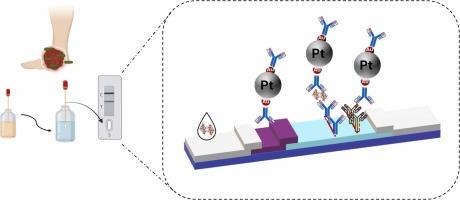Use of bimetallic PtAu nanoraspberries as novel labels in lateral flow immunoassays: Application for a chronic wound biomarker detection
IF 3.7
1区 化学
Q1 CHEMISTRY, ANALYTICAL
引用次数: 0
Abstract
Lateral flow immunoassays (LFIAs) are widely used point-of-care (POC) diagnostic tools due to their rapid response and ease of naked-eye detection. Gold nanoparticles (AuNPs) are commonly employed for colorimetric readout. However, these AuNP-based systems suffer from a relatively low sensitivity, which limits their application for the detection of low-abundance biomarkers. In this study, we propose the use of bimetallic platinum-gold (PtAu) nanoraspberries (NRs), consisting of a platinum shell surrounded by gold protuberances, as novel detection tags in LFIAs. The PtAu NRs surface morphology allows to enhance the nanoparticle:antibody conjugation ratio and to minimize unspecific absorptions, compared to that of the traditional AuNPs. Moreover, the intense purple coloration of the PtAu NRs provides superior visual contrast against the white background of lateral flow strips. All these features lead to improved performance in terms of sensitivity and specificity compared to the use of AuNPs. We also demonstrate the application of the PtAu NRs in an LFIA platform for the detection of myeloperoxidase (MPO), a key biomarker of chronic wound infection, at clinically relevant levels in artificial wound exudates with also high selectivity versus potential interferents. In addition, semi-quantitative analysis using a smartphone and ImageJ software showed a linear correlation between the normalized color intensity and the logarithm of MPO concentrations over the 50–5000 ng/mL range, achieving an estimated limit of detection of 1.8 ng/mL. These findings highlight the potential of PtAu NRs to improve LFIA performance and lay the groundwork for their use in multiplexed POC diagnostics.

双金属PtAu纳米酸梅在侧流免疫分析中的应用:用于慢性伤口生物标志物检测
侧流免疫测定(LFIAs)由于其快速反应和易于肉眼检测而被广泛应用于即时诊断(POC)工具。金纳米颗粒(AuNPs)通常用于比色读出。然而,这些基于aunp的系统灵敏度相对较低,这限制了它们在检测低丰度生物标志物方面的应用。在这项研究中,我们提出使用双金属铂金(PtAu)纳米覆盆子(NRs),由金突起包围的铂壳组成,作为LFIAs中的新型检测标签。与传统的aunp相比,PtAu NRs的表面形态可以提高纳米颗粒与抗体的结合率,并最大限度地减少非特异性吸收。此外,PtAu核磁共振区的深紫色与侧流条带的白色背景形成了良好的视觉对比。与使用aunp相比,所有这些特征都提高了灵敏度和特异性。我们还展示了PtAu核糖核酸在LFIA平台上用于检测髓过氧化物酶(MPO)的应用,MPO是慢性伤口感染的关键生物标志物,在人工伤口渗出液中具有临床相关水平,对潜在干扰物也具有高选择性。此外,利用智能手机和ImageJ软件进行的半定量分析显示,在50-5000 ng/mL范围内,归一化颜色强度与MPO浓度的对数呈线性相关,估计检出限为1.8 ng/mL。这些发现强调了PtAu NRs在改善LFIA性能方面的潜力,并为其在多路POC诊断中的应用奠定了基础。
本文章由计算机程序翻译,如有差异,请以英文原文为准。
求助全文
约1分钟内获得全文
求助全文
来源期刊

Sensors and Actuators B: Chemical
工程技术-电化学
CiteScore
14.60
自引率
11.90%
发文量
1776
审稿时长
3.2 months
期刊介绍:
Sensors & Actuators, B: Chemical is an international journal focused on the research and development of chemical transducers. It covers chemical sensors and biosensors, chemical actuators, and analytical microsystems. The journal is interdisciplinary, aiming to publish original works showcasing substantial advancements beyond the current state of the art in these fields, with practical applicability to solving meaningful analytical problems. Review articles are accepted by invitation from an Editor of the journal.
 求助内容:
求助内容: 应助结果提醒方式:
应助结果提醒方式:


